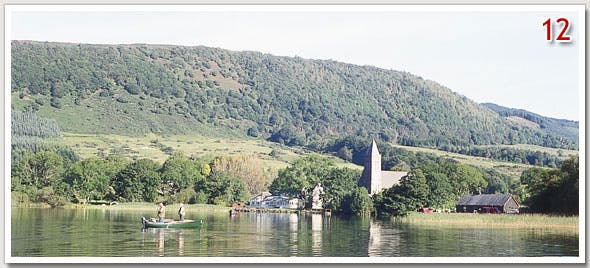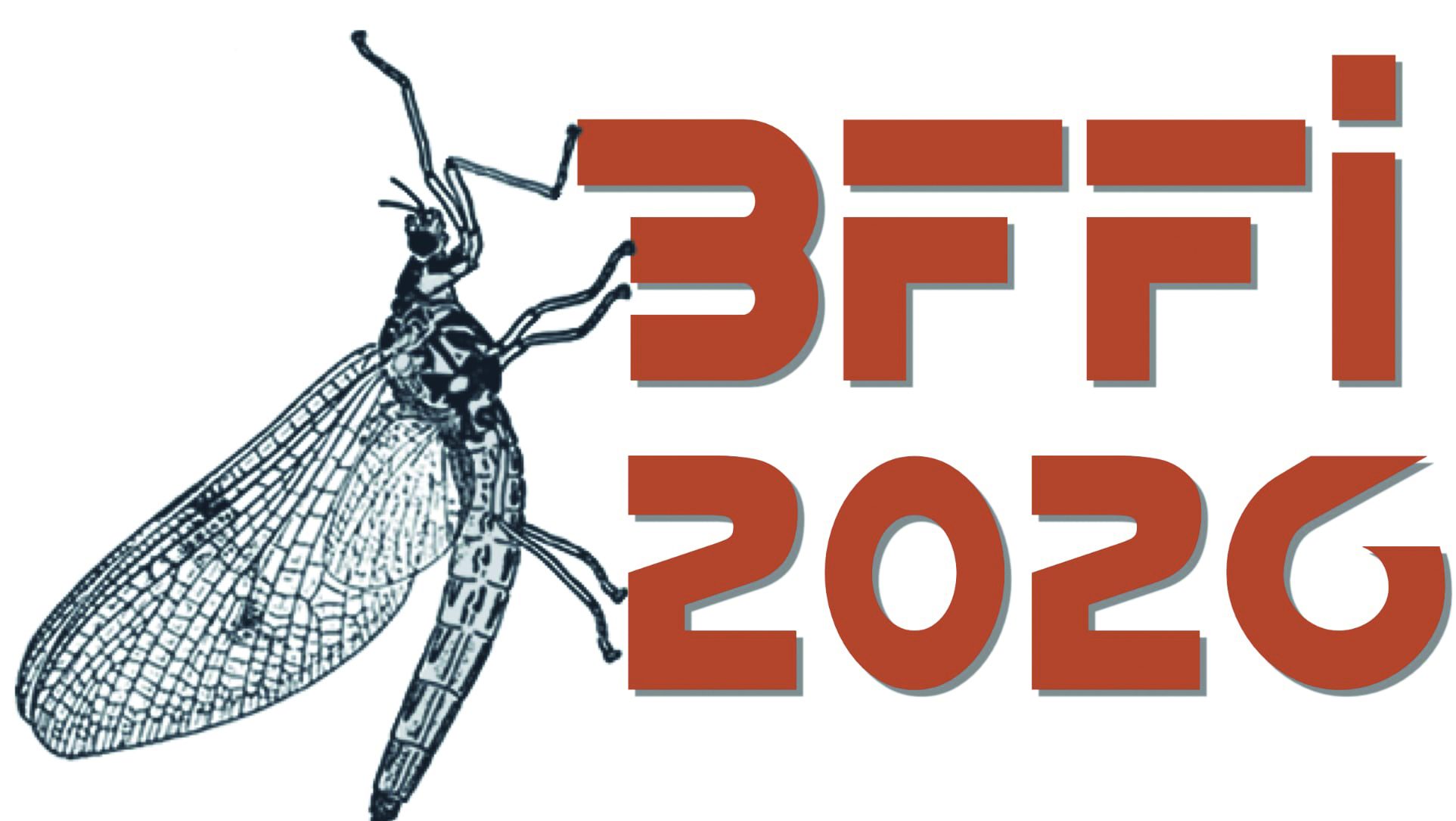STILLWATER AND RESERVOIR FLY FISHING GUIDE: LAKE OF MENTEITH
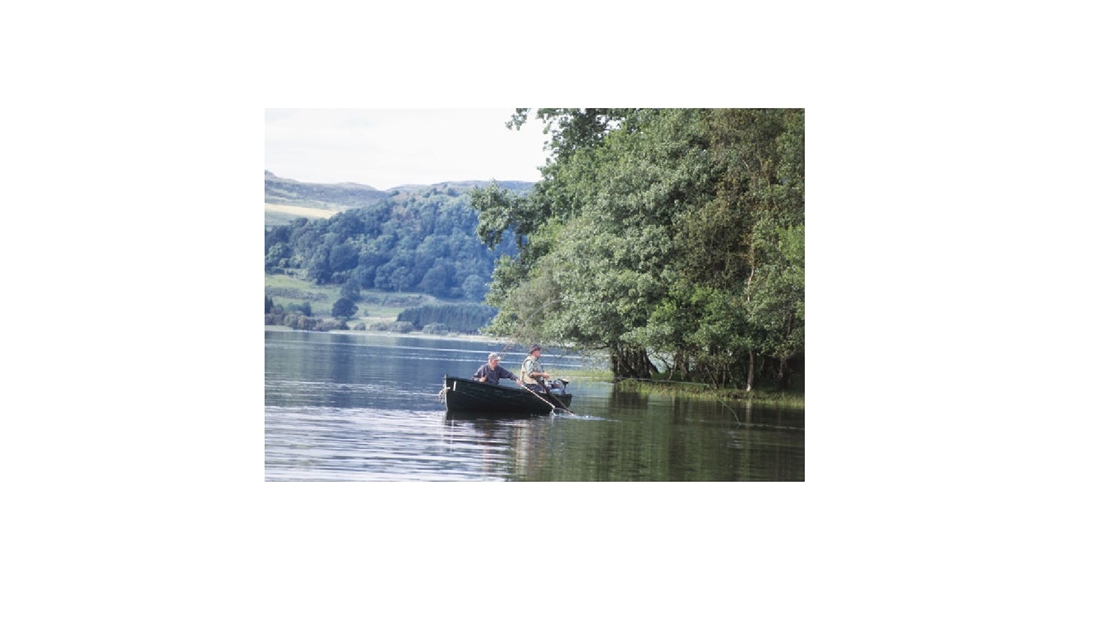
High mountains, green forests, deep lochs. This is the Trossachs, where Bonny Prince Charlie hid from the Redcoats. It’s also the location for one of Scotland’s most important trout fisheries, the Lake of Menteith.
IAN MUCKLE, with the help of three local experts, is your guide to the best drifts, flies and tactics on this scenic 600-acre natural lake.
Besides being one of the most productive boat fisheries in the country, the Lake of Menteith is also one of the most scenic. Part of that superb Scottish countryside which encompasses the famous Trossachs, the lake is surrounded by a spectacular mix of mountain and woodland.
The peak of Ben Lomond stretches skywards on the western horizon, while the slopes surrounding the Lake are covered with mature trees including oak, rowan, birch, beech and a variety of conifers. These are populated by a wealth of bird life, and the water environment is home to a diverse range of waterfowl. But the stars of the show are undoubtedly the ospreys, which work the Lake regularly and often plunge in to the water quite close to the angling boats.
Not that fishery manager Quint Glen begrudges these spectacular fish hawks a few trout. There is no shortage of these at Menteith, and apart from the anglers’ quarry, there are pike, perch and, rather unusually for a Scottish loch, roach.
No lack of fry, then, to feed the rainbows and browns. And that’s not to mention the other underwater trout fodder in this shallow and rich location, with its vast larder of snails, shrimps, larvae, daphnia and other tasty morsels.
Quint took over as fishery manager in 1998, and it is no secret that the place has blossomed amazingly since his arrival. By lowering the stocking density of the fish for restocking, there has been a tremendous improvement in the condition of the trout, and a further bonus is that the fish have attained a larger weight prior to stocking. Quint improved the overwintering prospects by stocking all triploids, and introduced a pike management policy which allowed smaller pike to be removed if necessary, giving the larger predators the chance to control the plentiful coarse fish.
A major improvement was the restocking of the Lake by boat and distribution of the stocked trout all over the fishery, which means that anglers can come across fish anywhere in those 640 acres.
Apart from the trout, Quint also turned his attention to the boats, and has upgraded the fleet and provided new and reliable engines. “My main plan is to preserve the Lake as a fishing amenity,“ says Quint, “And to safeguard the unspoiled local environment and the tranquility of the surroundings.“
Just how exciting the sport can be on Menteith was brought home to me when I was a guest of my mate Jim Boyd, PR man at the Lake, at the back end of last season. We had a magic day catching some hard-fighting, well-conditioned rainbows in the 2lb 8oz to 4lb class. The fact that you can often catch these fish on dry fly or Buzzer tactics is a major plus, though of course, other methods have their devotees. John Buchanan has made an art form of using the small Booby Nymph on the Lake.
It is to three of those Menteith top guns that I have turned to in formulating the major drifts and the way to fish them. I really appreciate them sharing their expertise, and what’s also pleasing is that although I sought their views individually, the three of them were almost totally in agreement as far as wind direction and times to fish were concerned.
All are former Scottish internationalists and well-known names on the Scottish angling scene. Malcolm Anderson, of Crieff, has a track record second to none on the Lake, and is a master of various methods. Jimmy Millar, of Edinburgh, is perhaps best known for his prowess with the dry fly on the loch, though again, he can adapt to any style. And Jimmy McBride, one of Scotland’s top fly dressers and a tackle dealer in the capital, has actually designed patterns such as the Blobby specifically for the Lake.
UNDERSTANDING THE WIND
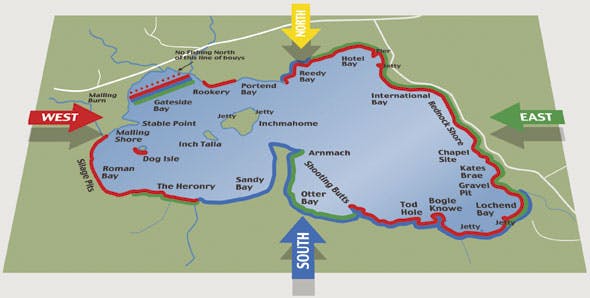
The prevailing south-westerly wind suits most drifts, but a strong westerly can make setting off from the beach a bit tricky. An easterly wind in very hot conditions can make the fish go deep and difficult to reach, and any on/off wind causes the rainbows to go up and down like yo-yos as they follow the oscillations of the thermocline. An East wind reverses the Westerly drifts, and can be favoured on the Heronry. A Northerly is generally not a wind you want.
1. International Bay/ The Road Shore
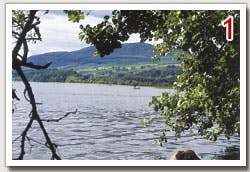
As you leave the harbour, it’s worth glancing behind and admiring how the old church spire dominates the backdrop, with the woods and hills framing the building. Head left, and the first major drift you come to, and one of the most popular areas on the water, is the Road Shore, sometimes still known by the old name of Rednock Shore. The depths run from 3ft to 15ft, though the Road Shore Deeps, which hold plenty of fish in warmer weather, are over 40ft. Pulling methods, dries and nymphs can all be effective, and it is a case of experimenting to discover the most successful tactic on the day.
Top tip: Jimmy Millar says: “In an onshore wind, make sure your last cast is right on to the stones, since the trout are often very tight to the margins. Avoid leaving the drift on full throttle as that spoils it for others.”
Best times: All season
Best winds: West or East
- Kate’s Brae
Can be inconsistent, and blows hot and cold, though it’s an area which should always be given a try, and often produces a fish or two on days when the angler is struggling. The shallow spit runs for some distance out from the point, and the depths go from 3ft to 10ft. Use an intermediate or floating line, and again, experiment with the business end of the tackle.
Top tip: Malcolm Anderson says: “Although the reeds close in can hold fish, don’t be afraid to go right out in the middle and drift across to the Gun Butts in the right wind direction. I think this drift fishes better further out.”
Best times: All season
Best winds: West or South West, though the drift can be reversed.
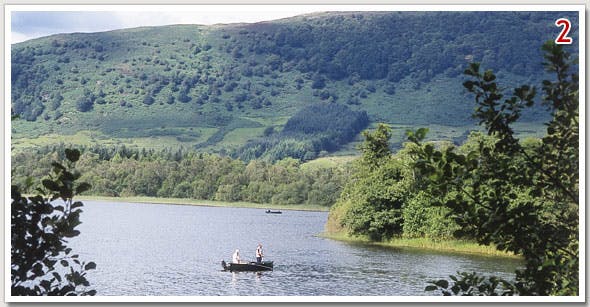
3. Lochend Bay
One of the top bays in the early months of the season, this is a relatively-shallow area with depths generally less than 10ft. There is usually a decent flow of water here because the lake runs out over a sluice just before the chalets. Pulling lures and mini lures can work well at the start, and an intermediate line should suffice. Look out for sipping rises close to the reeds in the summer, when dry fly tactics can be deadly. There are some larger fish in this sector.
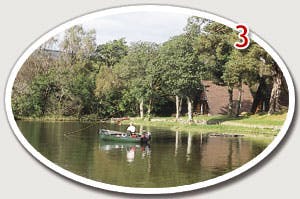
Top tip: Malcolm Anderson says: “Don’t forget the floating fry at the back end. The area just before the outlet can sometimes be a bit of a hot spot.”
Best time: Particularly good early in the season; back end can also produce.
Best winds: Most winds apart from a cold Northerly
4. Tod Hole
This is a small quiet bay, only around 5ft deep, and often ignored by many anglers, though those in the know realise that there are usually fish patrolling up and down near the reeds. There is also deeper water within easy reach in which the fish may be contacted in the warmer weather. A cautious approach is always necessary here as the trout are easily spooked. It’s a drift which will not take a lot of boat pressure.
Top tip: Jimmy Millar says: “It’s always possible to pick off some better-class fish on dry flies in this little corner, especially if it has not been disturbed.”
Best time: All year round, though May and June are
particularly good.
Best winds: Light West or South, though it can be fished in any light winds.
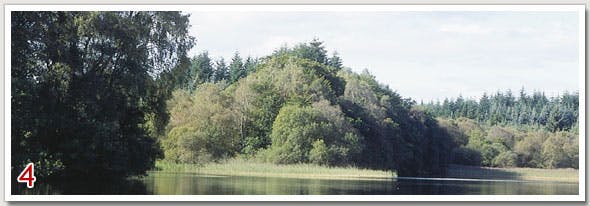
5. The Shooting Butts
This is one of the sections on the Lake which has really come to the fore since Quint Glen took over. Again, a stealthy approach is necessary, since it’s pretty shallow here, less than 5ft for much of its expanse. But it is one of the top dry fly areas on the Lake. Fish can be contacted right into the pike nets and beyond. Anglers are advised to keep on the move, searching new water and keeping an eye open for rising trout.
Top tip: Jimmy Millar says: “Always try this drift in May or June, especially when there’s a hatch of claret duns or vulgata mayfly. A well-presented dry fly can often sort out one of the grown-on residents to be found here.”
Best time: May and June, though it can fish well right through to the back end.
Best winds: South and East winds taking you across or in; you will find shelter here in a westerly in stormier conditions.
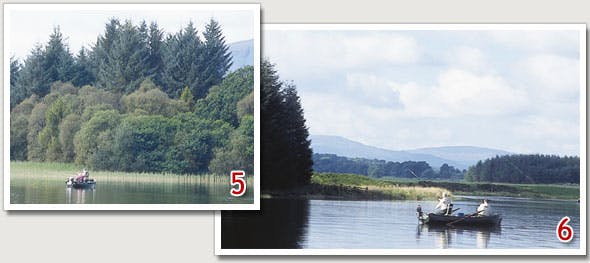
6. The Heronry
Shallow water close in, around 5ft, with much deeper stuff further out, around 30ft. An area which is renowned for quality rainbows, these often falling to dry fly techniques. However, Damsel Nymphs on an intermediate line will also do the trick. In a flat calm, you can often see the fish cruising around, and most anglers agree that you want as light a wind as possible to give you the best opportunities on the Heronry.
Top tip: Jimmy Millar says: “Use dry fly if you want to catch some real top-quality fish. Especially in the Autumn, look for collections of floating leaf litter – the fish won’t be far away.”
Best time: All season, though especially from May onwards; and always in light wind conditions.
Best winds: East, South or West
7. The Silage Pits
This is an area which can be a bit hit or miss, though when it’s on, it can be very productive. Fish here respond well to a variety of techniques, and the Booby Nymph can be deadly. It’s a drift which is always worth a look at any time of the season. You can take fish further out in water of around 15ft, though most anglers like a wind which takes them on to or along the shoreline.
Top tip: Jimmy McBride says: “Fish tight into the weeds or bank, and be prepared to change tactics, varying between pulling and dries until you find what the fish prefer.”
Best time: All season
Best winds: West or South-West

8. Dog Island/Malling Shore
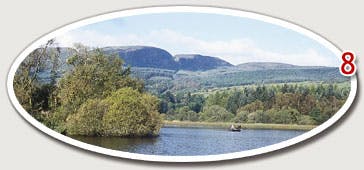
Another area where you should attempt to fish close in to the shore, though if there are a lot of boats operating in this drift, then the fish will move further out. Most of the water here is around 10ft deep, though there are areas where the depths fall away to 20ft. Although you can find trout here most of the season, there seem to be times when it’s a really ‘hot’ section, and others when it’s rather unproductive.
Top tip: Malcolm Anderson says: “I actually prefer the Malling Shore after the water has had a little heat in it, and then I find that dries or floating fry can really do the business. The later summer days seem to produce some real quality fish from this section.”
Best time: All season
Best winds: West or South-West
9. Gateside Bay
This used to be one of the most popular regions of the Lake, and often rejoiced in the name Cages Bay, since this was where the stocking cages were sited. It’s not as popular now since the changes in stocking policy meant a much wider distribution of fish over the whole fishery. There is plenty of deep water here, with 40ft not uncommon, and the North Inchmahome Deeps falling away to 70ft. One of the few places on the Lake where fast-sinking lines are useful, and top patterns include a White Cat and various Booby Nymphs.
Top tip: Jimmy McBride says: “If we’re having a spell of sunny warm weather, this is definitely worth a trip; it may save a blank day in a real scorcher. You can find fish close to either shoreline or even drift right across the middle.”
Best time: Summer onwards
Best winds: Any wind except a Northerly.
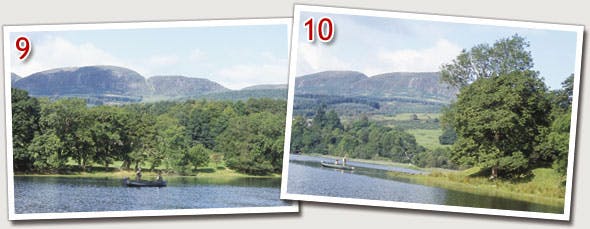
10. The Rookery
This is a number one area for those who can employ pulling tactics, though dry fly has its devotees under the right conditions. The drift runs from very shallow (3ft) to very deep (40ft). There is a productive area of shallows with lots of ridges just out from the reed beds, where a burn flows in at the back of this vegetation. Sometimes, some of the older resident fish will lie up in this area, though they are not easy to approach, especially in a flat calm.
Top tip: Jimmy McBride says: “I know it’s a top pulling area but I enjoy using dry fly when it’s calm, and find it particularly effective towards the tail end of the season.”
Best time: All season if conditions are right.
Best winds: West or South-West.
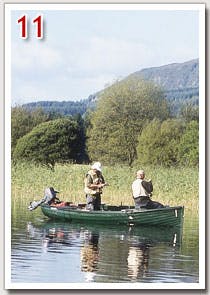
11. Reedy Point/Reedy Bay
Another shallow area with underwater features such as a sunken island. Various tactics will work, including floating line and nymphs, intermediates and mini lures and dries, the latter especially in the evenings. If the wind is taking you into the reeds themselves, don’t give up until you are virtually casting your flies among the stems.
Top tip: Malcolm Anderson says: “The set of white buoys marking the sunken island highlights a great feeding area, and pulling with a fast intermediate is very productive at the start of the season when the pinhead fry are around in numbers. It’s a superb dry fly spot in the warmer weather, with large quality fish to be had all year round. Fish are always patrolling the reeds, but I do prefer the buoys area.”
Best time: All season
Best winds: South, South-West or West; preferably not too strong.
12. Hotel Bay
This is the finishing bay, and brings us back to the harbour area. It’s a region which always seems to hold fish, and though it is particularly rated at the start of the season, it really can fish well all year. There’s a variety of depths, from 3ft to 20ft, and pulling mini lures seems to be a technique by which you can cover most of the ground successfully; and it does take plenty of trout. You can use a wide range of lines here, from floater to Hi-D. If the Lake is busy, then it sometimes pays to go in there first thing; or if other boats are fishing the bay, leave it until things have quietened down. There is something extremely satisfying about playing a fish right in front of the Lake Hotel, where there’s normally a spectator or two to admire the proceedings.
Top tip: Jimmy McBride says: “Most of my larger fish have come from this drift, so be prepared. Go there after sustained periods of westerly winds, since these seem to direct trout into this general area.”
Best time: All season
Best winds: West or east.
